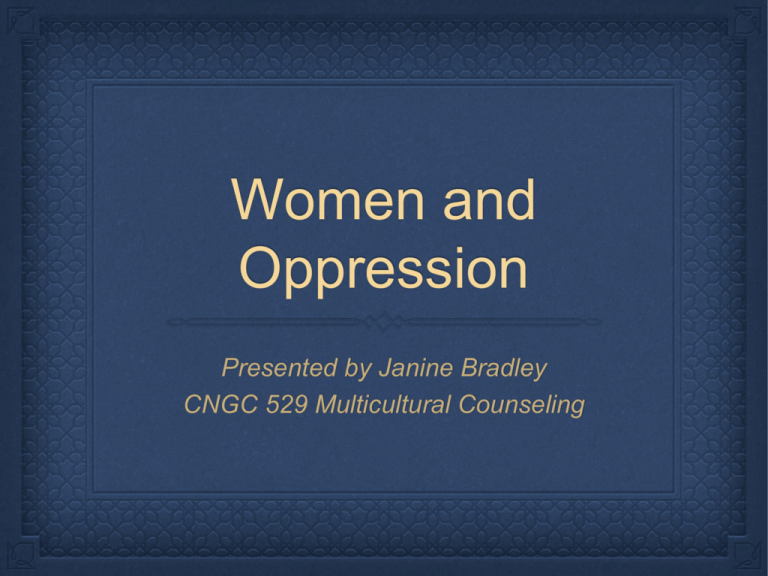
Women and
Oppression
Presented by Janine Bradley
CNGC 529 Multicultural Counseling
What is feminism?
What is feminism?
• Different types of women have always disagreed about which
issues were most important, and what the "real meaning of
feminism" is all about
• The term has constantly re-defined itself, and different groups
of women have had varying degrees of comfort using it
• A culminating definition that can be used today: Feminism is
the belief that men and women are equal. Because society
inherently affords men more privilege, social movements are
needed to achieve equality between men and women
(Freedman, 2002).
What are some stereotypes
about feminists?
Feminist Stereotypes
Feminists may be seen as:
Mannish
Lesbians
Man-haters
Are only white and upper middle class
Angry
Rejecting their gender
Historical Context
In agrarian past societies – women and men both worked equally to support the farm and household
During Industrial Revolution – idea of two “separate spheres”
1848, Seneca Falls, NY – first women’s rights convention held, led by Elizabeth Cady Stanton
1874 – women found the Women’s Christian Temperance Movement to prohibit alcohol
1878 - Women’s Suffrage Amendment is defeated in the senate. Will be brought back every congress
until it passes in 1920
Mid to late 1800’s – many women are diagnosed with “Hysteria” or a disease of the womb
1909 - National Association of Colored Women has branches in 20 states
1920 – Women’s Suffrage passes
1940’s – US enters WWII, many women join workforce to support war effort
1963 – Equal Pay Act – Outlawed separate pay scales for men and women in the same jobs
1963 – Betty Freidan writes The Feminine Mystique – “the problem that has no name”
1964 – The Civil Rights Act - Title VII
1966 – Founding of NOW (National Organization for Women)
1967 – Affirmative Action
1972 - Women’s Educational Equity Act and Equal Credit Opportunity Act
1972 – Title IX of the 1964 Civil Rights Act is passed
1973 – Roe v. Wade – gave women access to abortions in certain scenarios
1978 – Pregnancy Discrimination Act
1993 – Family Medical Leave Act
1994 – Violence Against Women, reauthorized in 2013
Values
Independence
Family/Relationships
Career
Political Rights
Appearance
Gender Identity
Norms and Behaviors
Client Voice
Using the Counseling Forces
Psychodynamic - Not always well-suited for women, ties to the patriarchy, too much
reliance on unconscious sexual tensions, rigid power structure between counselor and
client
Cognitive-Behavioral - Women may benefit from psyhoeducation about gender roles,
societal power differentials, unrealistic expectations and how these can affect women.
Good for women who may prefer to talk about cognitions over feelings.
Existential-Humanistic - Can be helpful for crisis intervention, working with survivors,
favors a more equal counseling relationship, beneficial because approach lets client take
the lead
Multicultural - includes feminist therapies which emphasize an egalitarian relationship,
empowerment, the recognition of inner strength, and discovering areas of personal
growth. Helpful for women who are affected by sexism/patriarchy
Clinical Implications
Feminist therapies can be helpful for women
Foster egalitarian relationship
Help women recognize the sexist social structure that surrounds and constricts them
Help women explore their personal power
Help women realize unexpressed anger
Help women define themselves independently of their multiple roles
Encourage women to care for and take time for themselves
Encourage skill development and self-esteem
Do not rely on diagnoses, instead look at the implications of diagnoses
Understand that the personal is political
Survivors of sexual assault/rape: give them the power back, help them to feel in control of the situation, may
experience phsycial symptoms of stress or anxiety
Counselors should be advocates for their clients and the issues that they face
Counseling Do's:
Listen
Start with the positives
Recognize strengths
Get to know them
Understand multiple identities and obligations
Be an advocate for their issues
Strive for an egalitarian relationship
Counseling Don'ts:
Make assumptions
Make decisions for them
Inflict power differentials
Rely on gender roles or stereotyping
Rely on diagnoses
Questions?
Photo Credits
Slide 7a: http://drjoaniversen.files.wordpress.com/2014/01/i-want-to-vote-but-my-wifewont-let-me.jpg
Slide 7b: http://drjoaniversen.com/womens-suffrage-postcards/#jp-carousel-476
Slide 10a: http://i2.cdn.turner.com/cnn/dam/assets/120215080128-contraceptive-2-storytop.jpg
Slide 10b: ://www.calculator.net/img/body-shape.gif
Slide 10c: http://kokh.images.worldnow.com/images/23654903_BG1.jpg
Slide 10d: http://cdn.business2community.com/wp-content/uploads/2013/05/HealthyBalance.jpg
Slide 10e: http://www.pasadenaadv.com/wp-content/uploads/He-Man-Woman-HatersClub-Report.jpg
References
Choate, L. H. (2009). Girls' and women's issues in counseling: a theory-based course design. Counselor Education and Supervision, 48(3),
179-193.
Freedman, E. B. (2002). No turning back: the history of feminism and the future of women. New York:Ballantine Books.
Howden, L. M. & Meyer, J. A. (2011). Age and sex composition: 2010 Census brief. U.S. Census Bureau. Retrieved March 21, 2014 from
http://www.census.gov/prod/cen2010/briefs/c2010br-03.pdf
Laws on violence against women. (2012, July 17). womenshealth.gov. Retrieved March 23, 2014, from http://womenshealth.gov/violence
against-women/laws-on-violence-against-women/index.html
Lawson, D. M. (2003). Incidence, explanations, and treatment of partner violence. (Practice & Theory). Journal of Counseling and
Development, 81(1), 19-32.
Levitt, D. (2004). Drive for thinness and fear of fat among college women: Implications for practice and assessment. Journal Of College
Counseling, 7(2), 109-117.
Levitt, D. H. (2010, Fall). Women and leadership: a developmental paradox? Adultspan Journal, 9(2), 66-75.
Lundberg-Love, P. K., Nadal, K. L., & Paludi, M. A. (Eds.). (2012). Women and mental disorders (Vol. 1). Santa Barbara, CA: Praeger.
Manninen, B. (2010). Rethinking Roe v. Wade: Defending the Abortion Right in the Face of Contemporary Opposition. American Journal Of
Bioethics, 10(12), 33-46.
Newman, L. M. (1999). White women's rights: the racial origins of feminism in the United States. New York: Oxford University Press.
Rosenzweig, R., Lichtenstein, N., Brown, J., & Jaffee, D. (2008). Who built America? Working people and the nation's history (Vol. 2). (3 ed.).
Boston: Bedford/St.Martin's.
Sue, D.W. and Sue, D. (2013). Counseling the Culturally Diverse: Theory and Practice (6th edition). New York : Wiley.







